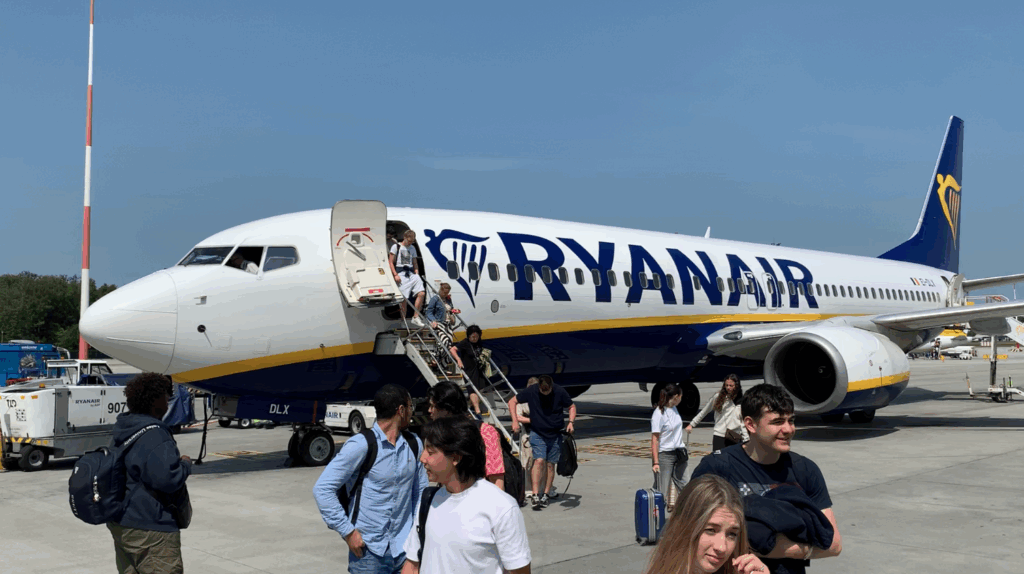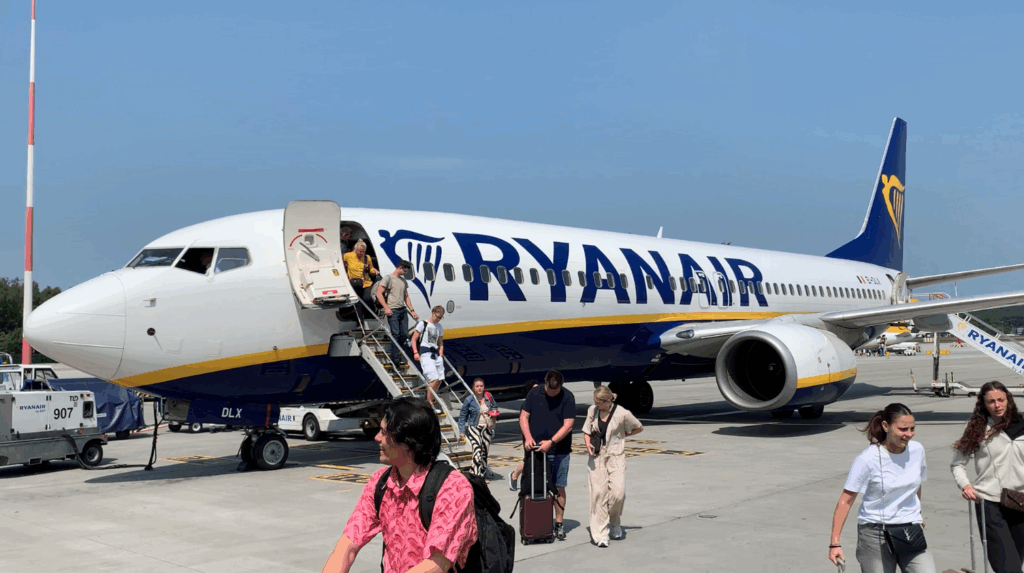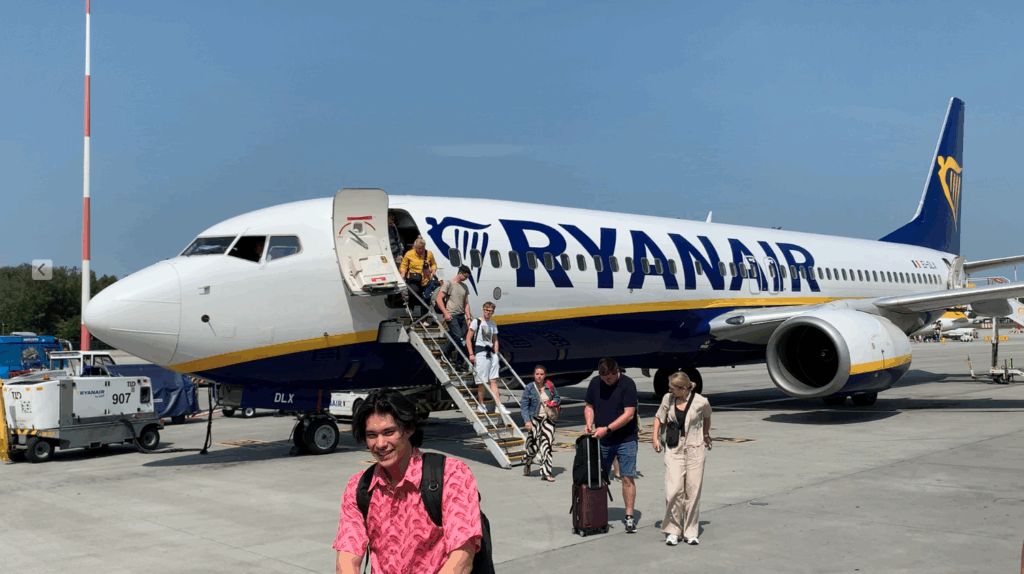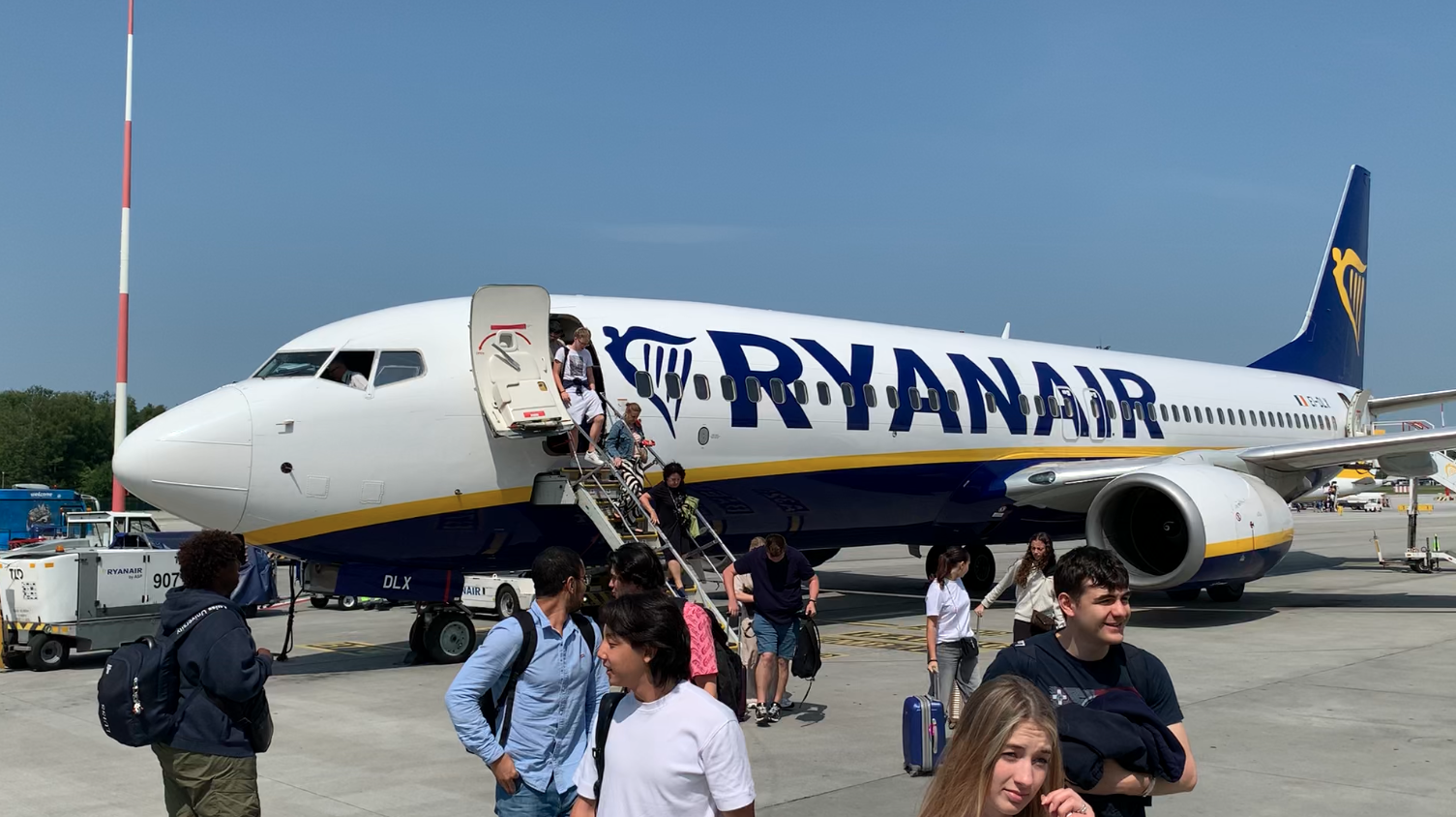Kraków 2025-10-11
Boeing B-737.



Boeing B-737 Original.
By the early 1960s, turbojet-powered aircraft had become a permanent fixture in passenger aviation. The DC-8 and Boeing 707 were flying across the Atlantic Ocean. A large family of mid-size aircraft already existed: the Boeing 727, McDonnell Douglas DC-9, BAC 1-11, and Sud Aviation Caravelle. Boeing Commercial Airplane Company was not yet the market leader. Its management decided to develop an even smaller aircraft to replace turboprop aircraft, which operated shorter distances and carried fewer passengers. They took a risk and developed the Boeing 737. The risk truly paid off, although others failed. For example, the French Dassault Mercury program was canceled.
The Boeing 737 was built with a then-innovative powerplant layout. Two engines were placed under the wings. Unlike the Caravelle, DC-9, or Tu-134; they were located at the rear, on the sides of the fuselage. Although engines had been placed under the wings before, there were four of them. We’re still talking about passenger planes.
Design work began on May 11, 1964. However, lack of funding soon hindered development. A sponsor had to be found—an airline interested in the future product. One was found in Europe. A preliminary agreement for the purchase of 21 aircraft was signed, and on February 19, 1965, the Boeing Company officially announced the commencement of work on a passenger aircraft designed for short-haul routes.
At this time, Boeing was chasing the frontrunners in this capacity class. Competitors were already flying. Therefore, to speed up the design and construction of prototypes, they used numerous components from Boeing 707 and 727 aircraft. The best solution was to use individual fuselage segments from their predecessors. This allowed for a 3 x 3-seat cabin arrangement per row. This was significantly more than in Soviet designs, such as the Tupolev Tu-134, which had a 2 x 2-seat arrangement. Despite its modest size, the aircraft accommodated over 100 passenger seats in its relatively wide fuselage. Furthermore, the complete forward fuselage, including the crew cockpit, was adapted. This meant that the 707, 720, and 727 aircraft had identical forward sections, with identical crew cabins. Back then, cockpits were for three people.
One of the key considerations for the new design was simple maintenance and operation. By placing the engines under the wings, access to them eliminates the need for lifts or walkways. The low-slung fuselage facilitates access to the lower-deck cargo door. The aircraft’s own steps freed it from the airport gangway (although this differed from the Boeing 727’s). Interestingly, with minor modifications, the aircraft could be operated at airports with a ground runway (RWY).
The prototype first flew on April 9, 1967, and was designated the Boeing 737-100. Five more examples soon joined the flight test program, including one with a fuselage lengthened by 1.88 meters, designated the Boeing 737-200. After completing 1,300 hours of flight testing, the FAA granted type approval to both versions (-100 and -200) on December 15, 1967. For the first time, the approval also included authorization for an automatic approach procedure in poor weather, meeting Category II requirements – a cloud base of 30 m and a forward visibility of 360 m.
Boeing B-737 Production
In 1968, series production began. Only 30 (29) units of the Boeing 737-100 were ordered and delivered to airlines. This was due to the existing enlarged version, the Boeing 737-200. The first series production version was the Boeing 737-130, built for a European aviation company. Twenty-one of these aircraft were built, with a capacity of 84 passengers. Boeing 737-100 series aircraft could carry a maximum of 103-115 passengers. They were powered by Pratt & Whitney JT8D-7, JT8D-9, and JT8D-9A engines (providing 2 x 64.74 kN of thrust). Commercial service began on February 10, 1968. Interestingly, as late as 1989, 26 aircraft of the -100 version were still in service.
At this point, a few words explain the designations of the Boeing 737 variants. Generally, the Boeing 737-100 should be called the Boeing 737 Series 1, as indicated by the number 1. The remaining two numbers or letters indicate a specific order for a specific customer. It’s similar to purchasing a car. The following are selected: the passenger cabin layout (or cabins), interior design, seat upholstery color, number of restrooms, galley equipment, and more, and above all, the exterior paint scheme for the entire aircraft. All of this is agreed upon during negotiations between the manufacturer and the user, and very often today between the manufacturer and the leasing company and the user.
Engineering in the Boeing B-737
Now a few words about the powerplant. The Pratt & Whitney JT8D-7 engine is a variant of the engine used to power the Boeing 707. The engine was developed specifically for the Boeing 727 in February 1964, with a thrust of 2 x 64.5 kN, based on the Pratt & Whitney J-52 military engine. The engine is a twin-shaft, dual-flow turbojet with a flow ratio of 0.96:1. It features an air intake, a two-stage fan, a four-stage low-pressure compressor, a seven-stage high-pressure compressor, an annular combustion chamber, a two-stage high-pressure turbine, a single-stage low-pressure turbine, an exhaust nozzle, and a thrust reverser. The JT8D engine family offers thrust ranging from 62.00 kN to 77.00 kN.
Interestingly, this engine was purchased by the Swedes, an afterburner was added, and used to power the Viggen combat aircraft.
Boeing B-737 Original Operations.
When the Boeing 737-100 entered service, the company took on another enormous challenge, one that fascinated the entire free world – the Boeing 747 Jumbo Jet (first flown on February 9, 1969, and still in production). At that time, the world was also fascinated by the construction of the first supersonic passenger aircraft: the Concorde (UK and France) and the Tu-144 (a Soviet aircraft, based on French designs, unfinished, and plagued by numerous crashes).
Meanwhile, Boeing 737 series -100 and -200 aircraft, as the Original, continued to be produced (1967-1988), and the market for users was growing.
The Boeing 737-200 was the second version of the aircraft. The primary change was the extension of the fuselage by 1.88 m. This increased seating capacity to 130 with a seat pitch of 74 cm, or 115 with a seat pitch of 86 cm. The powerplant, wings, and equipment remained unchanged. The first flight was performed on August 8, 1967, and service began on April 28, 1968. 1,081 examples were built.
One of the last Boeing 737-200 variants was the Boeing Advanced 737-200. The first flight was performed on April 15, 1971, and service began in June 1971. Standard seating was 8 in First Class, and 102 in Tourist Class. Engines were used; JT8D-9 A (2 x 64.45 kN), JT8D-15 A (2 x 68.96 kN), JT8D-17 A (2 x 71.12 kN), JT8D-17 AR (2 x 77.40 kN).
Perhaps the most revolutionary change, however, was the elimination of the navigator’s position. This reduced the crew to just two pilots. The issue of reducing the crew to two caused considerable tension between the flight crew and the management of the transport companies at the turn of the 1970s and 1980s.
Over the following years, the Boeing 737-100/-200 underwent a series of modernizations and modifications. Passenger, cargo, and freight variants were developed. Military versions designated T-43A were built, intended for navigator training. Military versions for radar surveillance and patrol were also built. A version designated Corporate 77-32 was also built as a luxury executive aircraft. Additional fuel tanks allowed for an increased range of 7,412 km with a payload of 1,134 kg.
Between 1969 and 1971, numerous improvements were made to the aircraft’s design. More efficient thrust reversers were installed, wing turbulators were modified, and the sealing of the flaps and slats in the retracted position was improved. Kits for these modifications were offered free of charge to owners of the first 134 aircraft. In newly built aircraft, the flap deflection capacity was increased to 25 degrees for takeoff and 40 degrees for landing, and the flaps were strengthened. In 1971, further changes were introduced, enabling the aircraft to be operated at airports with a shorter runway (RWY) of 1,220 m. The leading edge slats, Kruger flaps, and engine nacelle fairings were modified. The landing gear brakes and shock absorbers were improved. These changes resulted in the addition of the word “Advanced” to the aircraft’s name. For over 15 years, the Boeing Advanced 737-200 was the standard version of the 737.
Production of the Boeing 737 Original aircraft continued until June 1988. 1,114 Boeing 737-200s of all variants were built. As of December 1989, 1,053 were in service. At the turn of the 1980s and 1990s, they were gradually replaced by subsequent Boeing 737 versions.
Boeing B-737 Classic.
In the late 1970s, Boeing developed new Boeing 757/767 commercial aircraft. These were built using new materials and technologies. Computerized instrument panels appeared in the flight deck. More fuel-efficient, quieter, and even more reliable turbofan engines were also introduced, with significantly increased bypass ratios.
The Boeing 737-300 and the new CFM-56 engines.
The Boeing 737-200 continued in production and sold well. This innovation was readily incorporated into the next variant, designated the Boeing 737-300. Care was taken to ensure that the aircraft retained its key advantages: ease of operation and maintenance, and versatility.
The Boeing 737-300, the prototype of the new family, began in 1980. It was intended to be produced for a limited time alongside the older Boeing Advanced 737-200.
Compared to the B-737-200, the fuselage lengthened by 2.64 meters (9.5 ft) by inserting two new fuselage sections, one forward (111.6 cm) and one aft (152.4 cm) of the wings. This change was made possible by the use of a completely new powerplant. Boeing designers decided to use a new generation of fan engines, designated CFM-56. These engines were developed in a joint American-French effort. Their large size, dictated by the large fan diameter, forced the designers to extend them forward of the wing and develop entirely new engine nacelles. The nacelles were made of composite materials. To increase the engine’s ground clearance, the nacelles were given a flattened lower section, resulting in a pear-shaped cross-section. The new engines reduced fuel consumption by 30% while producing significantly more thrust.
The wing was also redesigned. The spars and skin were reinforced. All moving surfaces of the wings were made of composites.
The passenger cabin utilized the same solutions as the Boeing 757. This allowed the relatively narrow fuselage to maintain a level of comfort similar to that found on board wide-bodied aircraft. The hand luggage compartments were enlarged, allowing for the storage of items measuring 152 cm in length and weighing 82 kg. The fuselage’s length increased passenger capacity to 120-149.
In the flight deck, previously limited to two pilots (see above), a computer-aided flight management system (FMS) was introduced. This system automates many of the crew’s activities during flight. It performs tasks previously assigned to the navigator and flight engineer. It uses ground-based radio beacons to control the aircraft’s course (GPS did not yet exist). The system utilizes virtually all the aircraft’s sensors. Two small, color monitors were installed in front of each pilot. The upper monitor primarily displays the artificial horizon. The lower monitor displays the airborne communications situation. Gauges and clocks displaying engine operation were also integrated. These changes resulted in the elimination of some of the old electromechanical instruments. The airframe itself incorporated new materials: epoxy-graphite composites, Kevlar, and new aluminum alloys. Most of these were flame-retardant.
Standard passenger cabin capacity is 8 seats in business class and 120 seats in tourist class. The aircraft was powered by engines; General Electric – Snecma CFM 56-3-B1 (2 x 88.97 kN) or CFM 56-3-B2 (2 x 97.80 kN).
Assembly of the prototype began in March 1981, and rollout was performed on January 17, 1984. The first flight was performed on February 24, 1984. On March 2, 1984, the second prototype joined the flight tests. On November 14, 1984, the aircraft received FAA type approval. The first aircraft was delivered to USAir on November 28, 1984. The airline initially ordered 10 aircraft.
With this new version, boasting significantly improved performance and operational parameters, Boeing set a sales record, receiving orders for 252 aircraft in 1985. By December 1989, a total of 807 machines had been produced and ordered, of which 577 were already flying.
Before the next passenger variant was introduced, Boeing offered a corporate version, designated the Corporate 77-33. It featured approximately 20 seats, a conference room, bedrooms, a bathroom, a galley, and a toilet.
Boeing B-737-400.
The next version, the Boeing 737-400, was created by further lengthening the fuselage by 2.90 meters. Additional segments were added forward (168 cm) and aft (122 cm) of the wings. The fuselage length increased to 36.45 meters. This positioned the Boeing 737-400 in the 150-seat passenger segment, competing with the Airbus A320 and McDonnell Douglas MD-80. Standard capacity in two classes is 8 + 138 passengers, and in a single-class configuration, up to 159 passengers. Other sources indicate a range of 135-172 seats. In addition to the aforementioned engines, the CFM 56-3-C1 (2 x 104.57 kN) variant is also used for propulsion. The wing structure has been reinforced to support a maximum landing weight of 54,885 kg.
The program launched in June 1986. The first flight took place on February 19, 1988. The aircraft entered service with Piedmont Airlines in September 1988. By December 1989, 74 aircraft were in service, and an order for another 53 was being fulfilled.
Boeing B-737-500.
The next version is the Boeing 737-500. And here, airlines have the decisive say, seeking the most suitable aircraft for their needs. For the first time in the history of the Boeing 737, its fuselage was shortened rather than lengthened. Compared to the Boeing 737-300, the fuselage was shortened by 2.40 meters. It is only 47 cm longer than the Boeing 737-200. The final fuselage length is 29.80 meters.
In May 1987, construction of the Boeing 737-500 prototype began. The maiden flight took place on June 30, 1989, lasting 2 hours and 10 minutes. Flight testing included 300 hours of flight time. FAA type approval was granted on February 12, 1990, and the first aircraft were delivered to Southwest (USA) and Braathens (Norway) at the end of February 1990. By June 1989, the order had reached over 153 aircraft.
The aircraft’s standard capacity in a two-class configuration is 8 + 100 seats, and in a single-class configuration, 122 or 132 seats. This positioned the Boeing 737-500 as a competitor to the Dutch Fokker 100 and the American McDonnell Douglas MD-87. The aircraft was equipped with General Electric/Snecma CFM 56-3-B 1 (2 x 88.97 kN) or CFM 56-3-B 4 (2 x 82.00 kN) engines.
The -300, -400, and -500 series aircraft allowed airlines to offer a wide range of short- and medium-haul aircraft. They could reach almost any potential customer. The similar service levels of each variant allowed airlines to tailor their fleets to their specific needs. Without a doubt, the Boeing 737-300, -400, and -500 family of aircraft; Later designated the Classic, it strengthened Boeing’s position in the aviation industry. Production of the Classic family lasted from 1983 to 2000. By December 1990, Boeing had received a total of 2,727 orders for the Boeing 737 and had built 1,853 units.
Boeing B-737 Next-Generation.
The Boeing 737 proved to be such a successful aircraft that only the Boeing 737 could replace it.
In the 1990s, a third family of Boeing 737 aircraft appeared, comprising the -600, -700, -800, and -900 series, as the Next-Generation. The most significant changes occurred in the avionics equipment and materials used. Significant changes also occurred in the production organization, as discussed in a separate article. Production began in 1996, and by January 2011, 3,528 Boeing 737 Next-Generation aircraft had been delivered.
The Boeing 737 Next-Generation’s main competitor is the European Airbus A-320. In 2011, the B-737 was sold in four sizes with seating configurations ranging from 110 to 210.
The inspiration for the next family came from the groundbreaking technologies used in the competing Airbus A320. Primarily, the fly-by-wire system and the side joystick. Boeing bucked the trend and invited potential customers to collaborate. Future users demonstrated that the aircraft should not lose the advantages of its predecessors. Switching crews to the new version shouldn’t be a major breakthrough for them. This would have entailed the cost of potential additional crew training. This led to the decision not to introduce the side joystick.
The most visible change in the flight deck was the introduction of the so-called glass cockpit. Electromechanical dials almost completely disappeared. In their place, large color LCD displays appeared. The location of some controls changed. The electrical system, as well as the IRS, APU, and de-icing systems, had to be completely redesigned.
The program launch was officially announced on November 17, 1993. The wing underwent significant changes and was practically redesigned from scratch. Its surface area was increased by 25 percent. The length of each wing was increased by 4.88 meters to 16.00 meters. This allowed for a 30 percent increase in internal fuel capacity. Winglets were added to the wingtips. Winglets offer numerous advantages. They improve the lift characteristics of aircraft equipped with them, allowing them to fly at lower speeds (commonly used in STAR and SID procedures) and climb much faster. Winglets eliminate wingtip vortices and reduce fuel consumption.
The engines were still from the CFM 56 family, but were modified. They were designated CFM 56-7 B/C. They are quieter and more fuel-efficient. They also allow for intercontinental flights.
The flight test program was extensive and included 10 prototypes: three 600s, four 700s, and three 800s.
Boeing B-737-600.
The first version was the Boeing 737-600. It was initially offered first. However, it proved less economical than subsequent variants. On medium and short-haul routes, its engines consumed as much fuel as the larger 700 and 800, and it carried fewer passengers. Its advantages only became apparent on exceptionally long routes. Therefore, this aircraft did not gain much traction with potential buyers. Its counterparts were the Airbus A318 and Embraer 195. The first aircraft rolled off the production line in 1995 and entered service in 1998. The aircraft was sold to Scandinavian Airlines System. Only 66 (69) aircraft were built, and production was finally discontinued in 2006.
Boeing B-737-700.
The Boeing 737-700, initially designated the Boeing 737-300 X, rolled out on December 8, 1996, and its first flight took place on February 9, 1997. The aircraft seats 126 passengers in a two-class configuration, and 149 passengers in a first-class configuration. It has a range of 6,230 km (3,365 nautical miles). The aircraft was a response to the Airbus A319. The aircraft is frequently used on transatlantic routes. An extended-range version, designated the Boeing 737-700 ER (Extrended Range), was also developed. The range increased to 5,510 nautical miles. In service since 2007, 1,413 aircraft were built, and the aircraft was still in production in 2011.
Boeing B-737-800.
The −800 version was not initially planned. However, McDonnell Douglas ran into financial difficulties and was acquired by Boeing, which ordered the cessation of production of the MD-80 and MD-90 aircraft. Boeing 737-800 aircraft replaced them. The aircraft seats 162 passengers in a two-class configuration, and 189 in a single-class configuration. A max compact configuration is also available, with 33 rows on the left and 32 rows on the right, providing a total capacity of 195 seats. However, safety regulations certify the aircraft to carry 189 passengers. Therefore, the first and last rows are blocked. Generally, if the number of passengers on board is significantly less than 189, they are seated as close to the center of the cabin as possible to achieve the best possible balance.
Development of the aircraft began in 1994, and the first aircraft entered service in 1998. The aircraft burns 3,200 liters (850 US gallons) of fuel per flight hour. This is approximately 80% of the fuel burn of an MD-80 under comparable conditions. This equates to 18.5 liters (4.88 US gallons) per passenger. Alaska Airlines, by replacing its MD-80s with 737-800s, saved $2,000 per flight (in 2008). Therefore, in 2008, the airline purchased 26 additional 747-800s. A major user of the 737-800 is Irish low-cost carrier Ryanair, with a fleet of 272 aircraft, serving over 1,000 routes in Europe and North Africa.
The Boeing 737-800 has a gross weight of 70,530 kg. It can reach an altitude of up to 12,496 m, a speed of up to 840 km/h, and a range of up to 5,420 km. Boeing received orders for 3,966 of the aircraft. The aircraft was still in production in 2011.
Boeing B-737-900.
Boeing 737-900. The aircraft’s first flight took place on August 3, 2000. The first operator was Alaska Airlines, from May 15, 2001. The aircraft has grown significantly. It’s larger, seats more passengers, has a higher maximum takeoff weight, is more efficient, can fly at higher altitudes, and, most importantly, has a much longer range. The 737-900’s engines are powerful yet very quiet. The CFM 56-7 B 26 engines produce 117 kN (11,930 kg) of thrust each, for a total of 234 kN (23,860 kg), and the CFM 56-7 B 27 engines produce 121.4 kN (12,400 kg) each. The 737-900 is popular in the USA, but not in Europe. The first European airline to operate these aircraft is KLM Royal Dutch Airlines. The 737-900 was produced from 2001 to 2005, with only 52 built.
An extended-range version, the Boeing 737-900 ER, was also developed. The 737-900 ER features new exit doors and new fuel tanks. Certain aerodynamic improvements, included in the Short Field Performance package, distinguish it from the 737-900. Its newly designed wing allows for cruise flight at Mach 0.78 and short-haul flight at full acceleration at Mach 0.82. The 737-900 ER can accommodate 180 passengers in a two-class configuration or 215 in a single-class configuration. It is powered by CFM 56-7 engines (the same as those used in all Boeing NG aircraft). The range of this model is approximately 5,900 km (3,200 nautical miles).
The first aircraft of this type was produced on August 9, 2006, for the Indonesian low-cost airline Lion Air, which ordered 60 units. In addition to Lion Air, Continental Airlines, GECAS, and Sky Airlines have also purchased the 737-900 ER. The 737-900 ER is very popular. Production was still ongoing in 2011, with 413 aircraft ordered.
Boeing B-737.
To date (2011), 6,160 B-737s have been built. The company has an order for another 3,000. The Boeing 737 is so widely used that over 1,250 of these aircraft are in the air at any given time. On average, one B-737 takes off or lands somewhere in the world every five seconds.
In 2011, the Boeing 737 was the most modern aircraft in the world. The factory is located in Renton, USA. The aircraft is built on an assembly line, much like cars. Production time for one aircraft is nine days. 32 aircraft roll off the assembly line each month. In 2012, 38 aircraft were produced, and in 2013, 41.
Boeing B-737 MAX.
Boeing has already introduced into service an improved version of the Boeing 737 MAX 7/8/9, which will receive many solutions used in the most modern Boeing 787 commercial aircraft. But this type is described in other chapters.
Boeing B-737-800, EI-DLX.
Boeing B-737-800, EI-DLX; owned by Ryanair. Type 737-8AS. Serial Number 33600. Line Number 2082. The aircraft was built at the Renton (RNT) factory in October 2006. Handed over on 18 October 2006. Passenger cabin layout Y189. 2 x CFMI CFM56-7B26 engines installed. Ryanair has been the operator since the beginning.
Written by Karol Placha Hetman

